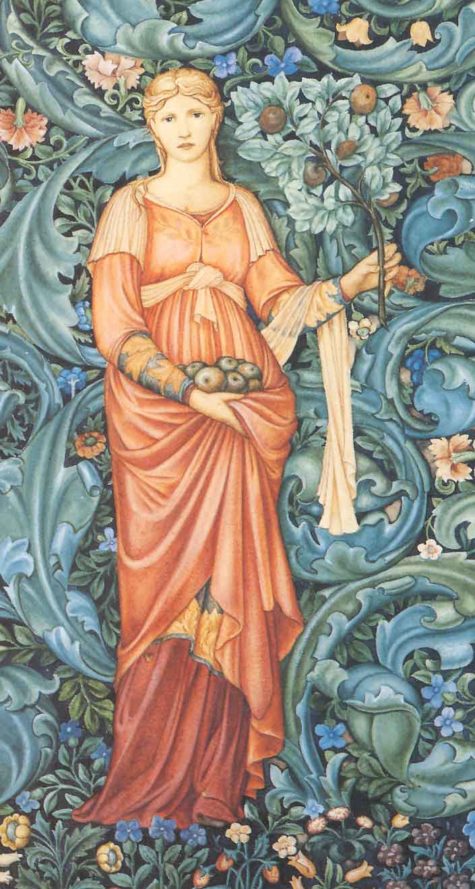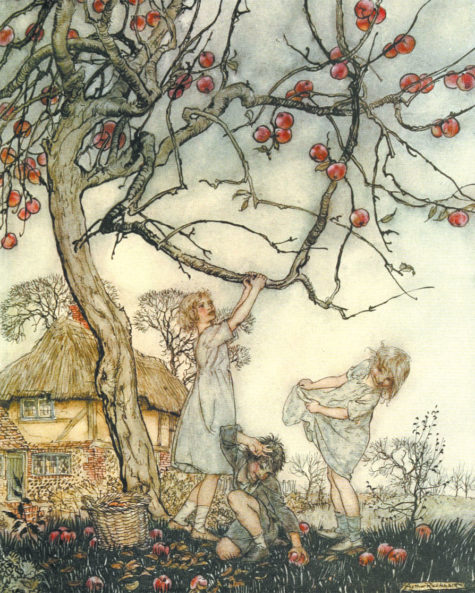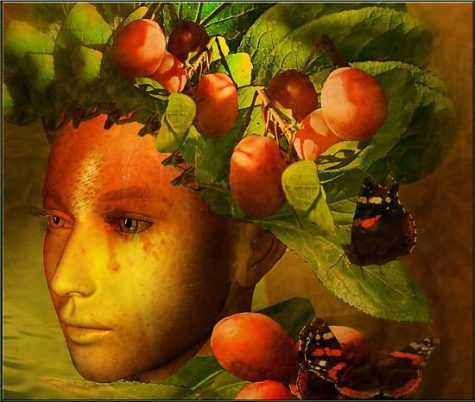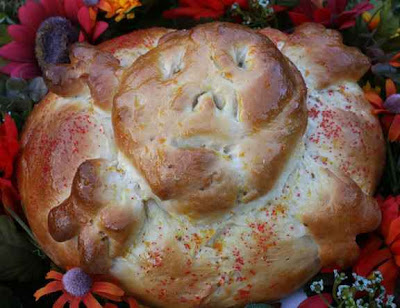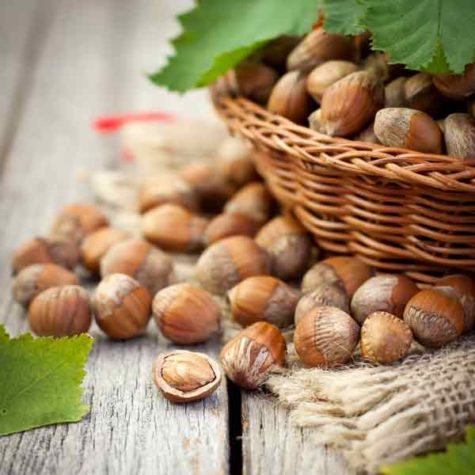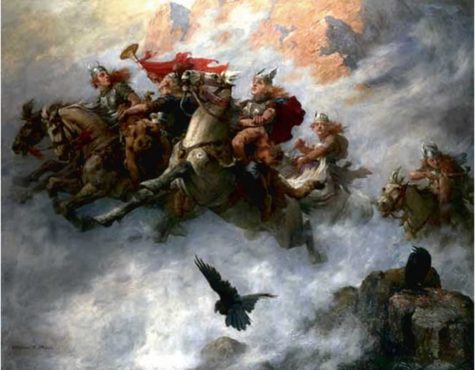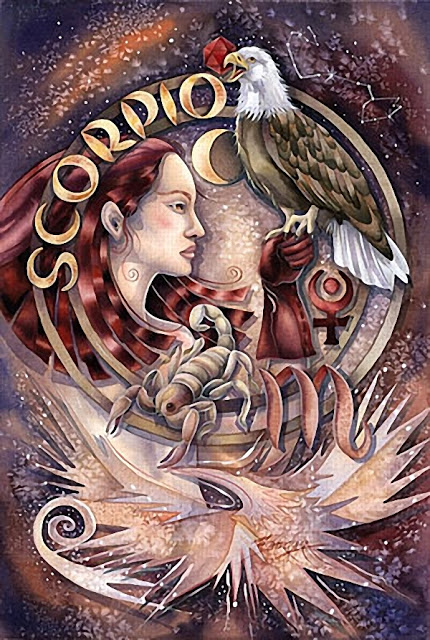Yearly Archives: 2017
Pomona’s Day of Honoring is often cited as November 1, making it a close match to the Celtic holiday Samhain. But sometimes it’s cited as August 13. Taken together, those days bracket the apple season. The earliest dessert apples begin to ripen in late summer, while the last storage apples finish in late autumn.
Even before the Romans added Pomona to the Samhain festivities, the Celts traditionally roasted apples and nuts in the bonfires. Pomona’s associations strengthened the role and symbolism of this fruit in connection with the holiday. This may be the origin of the modern custom of “bobbing for apples.”
To do on Pomona’s Day:
- Plant an apple tree.
Trees set out during the autumn planting season have a chance for extra root growth before they leaf out in the spring. Invoking Pomona’s blessing for her favorite type of tree will help your apple sapling grow big and strong.
This is especially helpful for grafted trees, which are a little more fragile than self-rooted trees and can use a boost from the goddess of grafting.
- Do some divination.
Do divination or other magic with fruits and nuts. The seeds, peels, and flesh of fruiting plants are useful in many types of divination and spellcraft. At this time of year, the veil between worlds is thin, making divination easier and more effective.
Divination with apples includes such things as cutting the peel from an apple all in one strip and tossing it to reveal the initials of one’s future spouce, placing apple seeds on the coals to see if they lie quietly (fortelling a happy relationship) or fly apart (foretelling heartbreak), and cutting an apple in front of a mirror to scry one’s beloved.
- Practice some Apple Magick.
Another set of practices draws on the apple’s qualities as a magickal fruit with power over the otherworld. These rituals deal with death and banishing. An apple may be cut in half and buried to cure a disease, settle a quarrel, or break a bad habit. Apples are also sometimes thrown to drive away evil spirits, or left out to feed the spirits of the dead so they do not trouble the living.
Ritual for Pomona’s Day
Here is a nice little ceremony to honor Pomona on her day:
- Colors: Red, yellow, green
- Earth
- Altar: Upon cloth of any or all of these colors, lay baskets of apples (preferably the old Roman variety “Lady”)and other tree fruit, a jug of cider, and a pruning knife.
- Offerings: Water fruit trees.
- Daily Meal: Vegetarian, with any food made with apples.
Invocation to Pomona
Lady of the Apple Tree
Whose red-cheeked visage greets the dawn,
Lady of the Pear Tree
Whose sweetness salves the questing tongue,
Lady of the Peach Tree
Whose blush transforms the morning sky,
Lady of the Plum Tree
Whose scent entices, smooth and smiling,
Lady of the Cherry Tree
Whose scarlet lips are drenched in raindrops.
Lady of the blossoming branch
Who entices bees to dance with you,
Lady of the secret orchard
Where Vertumnus gained his entry,
Where he came in secret, clothed in
Vestments of the ancient Crone,
God of growth, god of seasons,
God of turning, he took you there
As you offered up your nectar
And all the trees above you burst their buds.
Lady of the ancient ones, the Trees
Who give forth their children one by one
That we may know not just mere survival
But sweetness as well, help us to remember
The beauty and abundance of your gifts.
Chant:
Pomona Pomona
Pomum Pirum Prunus
Pax Pactum Promissio
Sources:
The Mourning Moon is upon us. As the days grow shorter and the sun’s life-giving fires are banked, sometimes it seems so dark we feel the light will never return. This moon, however, is a reminder that death is just a part of the endless cycle of life, death, and rebirth.
It’s also known as the Fog Moon or Snow Moon, depending on where you live. Some Native American tribes referred to it simply as The Moon When Deer Shed Antlers (although in most regions it’s more accurate to say they’re shedding their velvet – a buck doesn’t usually lose antlers until later in the winter, unless you’re very far north).
Correspondences:
- Colors: Gray, blues
- Gemstones: Lapis lazuli, turquoise, topaz
- Trees: Cypress, alder, hazel
- Gods: Bastet, Isis, Kali, Hecate, Astarte
- Herbs: Thistle, betony, verbena, fennel
- Element: Water
In the early Celtic society, November was the beginning of the new year, and so it makes sense to use the magic of this moon phase to celebrate new beginnings.
This is a time of washing away the baggage of the past and letting it go. Once you’ve done that, you’ll be able to focus on the joys of the future. During the Mourning Moon phase, say goodbye to bad habits and toxic relationships, and get a fresh start for the new year. Work on developing and strengthening your connection with Spirit.
The pan de muerto (Spanish for Bread of the Dead or Day of the Dead Bread) is a type of bread from Mexico baked during the Dia de los Muertos season, around the end of October and the official holiday is celebrated on November 2. It is a soft bread shaped in round loaves with strips of dough attached on top (to resemble bones), and usually covered or sprinkled with sugar.
Another bread in the form of a sphere on the top represents a skull. The classic recipe for Pan de Muerto is a simple sweet bread recipe with the addition of anise seeds.
Pan de Muerto is sometimes baked with a toy skeleton inside. The one who finds the skeleton will have “good luck.” This bread is eaten during picnics at the graves along with tamales, cookies, and chocolate.
Ingredients:
- 1/4 cup milk
- 1/4 cup (half a stick) margarine or butter, cut into 8 pieces
- 1/4 cup sugar
- 1/2 teaspoon salt
- 1 package active dry yeast
- 1/4 cup very warm water
- 2 eggs
- 3 cups all-purpose flour, unsifted
- 1/2 teaspoon anise seed
- 1/4 teaspoon ground cinnamon
- 2 teaspoons sugar
Instructions: Bring milk to boil and remove from heat. Stir in margarine or butter, 1/4 cup sugar and salt.
In large bowl, mix yeast with warm water until dissolved and let stand 5 minutes. Add the milk mixture.
Separate the yolk and white of one egg. Add the yolk to the yeast mixture, but save the white for later. Now add flour to the yeast and egg. Blend well until dough ball is formed.
Flour a pastry board or work surface very well and place the dough in center. Knead until smooth. Return to large bowl and cover with dish towel. Let rise in warm place for 90 minutes. Meanwhile, grease a baking sheet and preheat the oven to 350 degrees.
Knead dough again on floured surface. Now divide the dough into fourths and set one fourth aside. Roll the remaining 3 pieces into “ropes.”
On greased baking sheet, pinch 3 rope ends together and braid. Finish by pinching ends together on opposite side. Divide the remaining dough in half and form 2 “bones.” Cross and lay them atop braided loaf.
Cover bread with dish towel and let rise for 30 minutes. Meanwhile, in a bowl, mix anise seed, cinnamon and 2 teaspoons sugar together. In another bowl, beat egg white lightly.
When 30 minutes are up, brush top of bread with egg white and sprinkle with sugar mixture, except on cross bones. Bake at 350 degrees for 35 minutes.
Makes 8 to 10 servings.
Recipe found at: AzCentral
Early divination was often done using only the items at hand — sticks, vegetable peels, cloud formations, etc. Around the end of the harvest season, there wasn’t often much left in the fields.
However, nuts were often plentiful. Pecans, chestnuts, filberts and more would have been gathered up in baskets and stored, which made them the perfect medium for late fall divination. This is a similar celebration to Nutting Day, which falls in mid-September.
Filberts are the European variety of hazelnuts, and in some parts of England, they were used for divination purposes around Samhain night. In fact, for a while the practice was so popular that Halloween was sometimes referred to as Nut Crack Night. Filberts were placed in a pan over a fire and roasted. As they heated up, they would pop open. Young women watched the filberts carefully, because it was believed that if they popped enough to jump out of the pan, romantic success was guaranteed.
In some areas of Europe, the nuts were not roasted, but instead were ground into flour, which was then baked into special cakes and dessert breads.
These were eaten before bed, and were said to give the sleeper some very prophetic dreams. In a few regions, the flour was blended with butter and sugar to create Soul Cakes for All Soul’s Night.
Scottish poet Robert Burns describes a practice in which couples would roast a pair of nuts together, and the behavior of the nuts was indicative of the future of the relationship.
Burns says, “Burning the nuts is a favourite charm. They name the lad and lass to each particular nut, as they lay them in the fire; and accordingly as they burn quietly together, or start from beside one another, the course and issue of the courtship will be.”
Want to do your own Nut Crack Night divination? Select a pair of uncooked filberts. Assign a name to each for you and your lover. Place them in a pan over a fire, and watch to see what they do. Nuts that fly apart indicate that the relationship won’t last, but if they stay together, you’re practically guaranteed to be happy!
by Patti Wigington, ThoughtCo.com
Today is the Feast of the Einherjar: The chosen heroes who sit in Odin’s Hall are the Einherjar. Today we honor those dead kin who gave their lives for Family and Folk. If you have friends or family who died in battle, visit their graves today, if that is not possible, drink a libation in their memory.
- See also: Honoring the Einherjar
Note: Also called Fogmoon, this feast day is held on the nearest weekend to November 1st. A celebration of the war-dead and of Ragnarok, it is dedicated to Odin and Freya.
Scorpio is the eighth sign of the zodiac. The sun enters Scorpio at slightly different times each year, usually around Oct 22, sometimes the day before or the day after.
- Symbol: Scorpion
- Element: Water
- Gemstone: Topaz
- Keword: I Desire
Scorpios are forceful, determined, secretive, and emotional. They are naturally intuitive, and instinctively know what makes other people work. However, they keep their own motivations and true nature a secret. Scorpios are patient people who wait for opportunities and then act quickly, using surprise to their benefit. Scorpios usually know what they want, and they invariably achieve their goals in the end.
From 365 Goddess, we have this for today:
- Themes: Creativity; Sexuality; Passion; Instinct; Fire; Energy
- Symbols: Scorpion (or any stinging, hot items)
- Presiding Goddess: Isara
About Isara:
An ancient Mesopotamian goddess, Isara is known for her fiery nature. The Syrians specifically worshiped her in the form of a scorpion when they wished to improve sexual prowess or passion. In other traditions, Isara judges human affairs fairly but firmly, and all oaths made in her name are sacred.
To Do Today:
In astrology, people born under the sign of Scorpio are said to be creative, tenacious, sturdy, and sensuous, often internalizing Isara’s fire in their sign for personal energy. To do likewise, enjoy any hot beverages (such as coffee with a touch of cinnamon for vitality) first thing in the morning. This will give you some of Isara’s fire to help you face your day, both mentally and physically.
For those wishing to improve interest or performance in the bedroom, today is a good time to focus on foods for passion and fecundity. Look to bananas or avocados in the morning, olives, dill pickles, radishes, or licorice sticks as a snack, beans as a dinner side dish, and shellfish as a main platter. Remember to invoke Isara’s blessing before you eat. And, if you can find one, put the image of a scorpion under your bed so that Isara’s lusty nature will abide in the region and you can tap into it during lovemaking.
More About the Sun in Scorpio
The Sun is in Scorpio from approximately October 23 to November 21, depending on the year.
- Ruler: Pluto, Mars
- Modality: Fixed
- Season: Fall
- Metal: Steel, Iron
- Stone: Topaz, Opal
- Color: Gold, Purple
- Flowers: Chrysanthemum; Pansy
- Anatomy: Genital organs, bladder, bowels
- Attributes: passionate, perceptive, resourceful, possessive, psychological, prowling, determined, probing, fixed, focused.
Scorpios are known for their intensity. They are determined folk that absolutely throw themselves into whatever they do — but getting them to commit to something is rarely an easy task. In fact, it’s better not to even try to “get them” to do anything. Solar Scorpios absolutely have their own mind. And, their primary motivation is unlikely to be prestige (like their Capricorn friends), or even authority (Leos can have that, too)–it’s real power. Their power can absolutely be of the “behind the scenes” variety, just as long as they have it.
To others, Scorpios seem to have plenty of willpower. They probably do. Scorpios do know what they want, and they won’t go out and grab it at the wrong moment. They simply sit back, watch (quite expertly), and then get it only when the moment is just right. This apparent patience is simply their powerful skills at strategy at work.
Scorpio isn’t afraid of getting their hands (their bodies, their minds) dirty. The darker side of life intrigues them, and they’re always ready to investigate.
Scorpios simply never give up. They have tremendous staying power. They’re not in the slightest intimidated by anybody or anything. Confrontations are not a problem. In fact, talk to any Scorpio about their lives, and you’ll probably be in awe at all they’ve gone through. Trauma seems to follow them wherever they go. When Scorpio learns optimism, instead of expecting the worst, they’ll find that they possess amazing regenerative powers — the power to heal, create, and transform.
Source: Cafe Astrology
Lovely, summer-like days that occur around October 18 are called St. Luke’s Little Summer in honor of the saint’s feast day. In olden days, St. Luke’s Day did not receive as much attention in the secular world as St. John’s Day (June 24) and Michaelmas (September 29), so to keep from being forgotten, St. Luke presented us with some golden days to cherish before the coming of winter, or so the story goes. Some folks call this Indian Summer, but that officially occurs between November 11 and November 2
Traditional Catholic Celebrations:
Saint Luke’s Feast Day can be celebrated by reading the Acts of Apostles and praying the three canticles he preserved for us – the Benedictus, the Magnificat and the Nunc Dimittis. As the first Christian physician, Saint Luke is the patron saint of physicians and surgeons. For this reason, we honor Saint Luke on his feast day by praying through his intercession for doctors and those who care for the sick.
Found at: Almanac.com
The new moon is sacred to the goddess Hekate, and these cakes are ideal for use in rituals honoring her, as well as for Hekate Suppers, or an offering to leave at a crossroads. Many of the ingredients are sacred to the Dark Goddess, additionally there are 3 x 3 ingredients, using the number three which is also sacred to Hekate.
- 1 1/2 cups flour
- 1/2 cup of soft butter
- 1/4 cup of honey
- 1/2 tsp baking soda
- 1/2 tsp salt
- 2 tbsp black poppy seeds
- 1 egg
- 1/2 tsp almond extract
- 1 tsp anise seeds
Directions:
(If possible use organic ingredients and free-range fertile eggs.) Sift the flour, salt and baking soda together. Cream the butter, honey and egg. Blend the two mixtures together and add the remaining ingredients. Shape into small thin crescent shapes. Place with space between the shapes to allow for spreading during baking on a cool, oiled baking tray.
Bake at 350 F for about 12 minutes or until lightly golden.
~Sue Bowman, Keys to the Crossroads
The Dark of the Moon, those few days where the moon is not visible, just prior to the rebirth of the New Moon, are controversial. Some traditions will not cast spells during this period. Others. particularly those devoted to Dark Moon spirits like Hekate or Lilith, consider this a period of profound magickal power which may be exploited as needed.
In Arabic folk custom, it’s recommended that you keep an eye on moon phases. Whatever you find yourself doing at the moment when you first catch a glimpse of the brand new moon is the right thing for you to do.
More New Moon Lore:
- Almost every culture believed that if the New Moon came on Monday (Moon-day) it was a sign of good weather and good luck.
- Two new moons in one month were said to predict a month’s bad weather.
- Any new moon on a Saturday or Sunday was said to predict rain and general bad luck.
- Good luck will come your way if you first see the New Moon outside and over your right shoulder. You can also make a wish that will be granted. The best luck came from looking at the Moon straight on.
- In some parts of Ireland, upon seeing the New Moon, people bowed or knelt, saying: O Moon, leave us as well as you found us.
- Upon seeing the New Moon, bow to her and turn over the silver or coins in your pocket. This will bring you luck in all your affairs.
- If the New Moon is seen for the first time straight ahead, it predicts good fortune until the next New Moon.
- To encourage luxuriant growth, cut your hair on the New Moon.
- Wood cut at the New Moon is hard to split.
- The English had a saying that if a member of the family died at the time of the New Moon, three deaths would follow.
- Although the Koran expressly forbids worshiping the Sun or Moon, many Muslims still clasp their hands at the sight of a New Moon and offer a prayer.
From: Moon Magick and other sources
Traditionally, the each of the first ten days after the New Moon has it’s own attributes and qualities. Here’s the folklore on each of those days:
First Day: A good day for new beginnings. To fall ill on this day means the illness might last a long while. A child born at this time will be happy, prosperous, and live long.
Second Day: A good day for buying and selling and for starting a sea voyage. Also a good time for hoeing and sowing.
Third Day: Crimes committed on this day are certain to be found out.
Fourth Day: A good day for building, construction, and home renovations. Also a good day to be born on if you want to enter politics.
Fifth Day: The weather on this day gives an indication of what to expect for the rest of the month. It’s a good day for a woman to conceive.
Sixth Day: The best day for hunting and/or fishing.
Seventh Day: A good day for meeting and falling in love.
Eighth Day: A sickness begun on this day was thought to be likely to cause death.
Ninth Day: If the Moon shines in your face on this day, you may have twisted features or go mad.
Tenth: People born on this day are likely to be travelers or have a restless spirit.
Other Days: A New Moon on a Saturday or Sunday indicates rain, as does seeing the outline of the whole Moon at the same time as a New Moon. Furthermore, should the horns of a New Moon point upwards then the weather will be fair for the next lunar cycle, but if they point down, you can expect rain.
